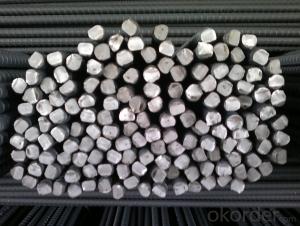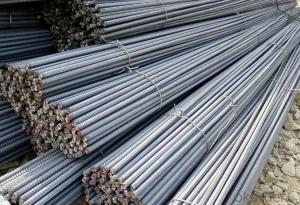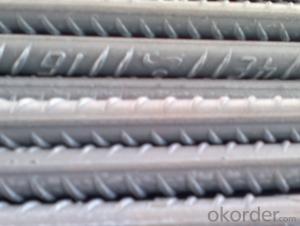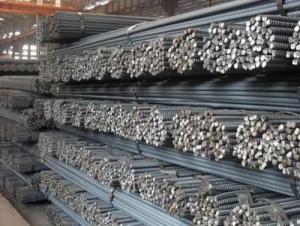GB Standard HRB400, 500 Hot Rolled Deformed Steel Rebars
- Loading Port:
- Shanghai
- Payment Terms:
- TT or LC
- Min Order Qty:
- 100 m.t.
- Supply Capability:
- 200000 m.t./month
OKorder Service Pledge
OKorder Financial Service
You Might Also Like
OKorder is offering GB Standard HRB400, 500 Hot Rolled Deformed Steel Rebars at great prices with worldwide shipping. Our supplier is a world-class manufacturer of steel, with our products utilized the world over. OKorder annually supplies products to African, South American and Asian markets. We provide quotations within 24 hours of receiving an inquiry and guarantee competitive prices.
Product Applications:
GB Standard HRB400, 500 Hot Rolled Deformed Steel Rebars are ideal for structural applications and are widely used in the construction of buildings and bridges, and the manufacturing, petrochemical, and transportation industries.
Product Advantages:
OKorder's GB Standard HRB400, 500 Hot Rolled Deformed Steel Rebars are durable, strong, and wide variety of sizes.
Main Product Features:
· Premium quality
· Prompt delivery & seaworthy packing (30 days after receiving deposit)
· Can be recycled and reused
· Mill test certification
· Professional Service
· Competitive pricing
Product Specifications:
Manufacture: Hot rolled
Grade: HRB400 500etc
Certificates: ISO, SGS, BV, CIQ
Length: 6m – 12m, as per customer request
Packaging: Export packing, nude packing, bundled
Deformed Steel Bar | ||
Diameter (MM) | Cross Sectional Area (MM2) | Theorectical Weight (KG/M) |
6 | 28.27 | 0.222 |
8 | 50.27 | 0.395 |
10 | 78.54 | 0.617 |
12 | 113.1 | 0.888 |
14 | 153.9 | 1.21 |
16 | 201.1 | 1.58 |
18 | 254.5 | 2 |
20 | 314.2 | 2.47 |
22 | 380.1 | 2.98 |
25 | 490.9 | 3.85 |
28 | 615.8 | 4.83 |
32 | 804.2 | 6.31 |
36 | 1018 | 7.99 |
40 | 1257 | 9.87 |
HRB335
Grade | Technical data of the original chemical composition (%) | |||||||
C | Mn | Si | S | P | B | |||
HRB335 | ≤0.25 | ≤1.60 | ≤0.80 | ≤0.045 | ≤0.045 | >0.0008 | ||
Physics capability | ||||||||
Yield Strength(N/cm2) | Tensile Strength(N/cm2) | Elongation (%) | ||||||
≥335 | ≥490 | ≥16 | ||||||
HRB400
Grade | Technical data of the original chemical composition (%) | |||||||
C | Mn | Si | S | P | V | |||
HRB400 | ≤0.25 | ≤1.60 | ≤0.80 | ≤0.045 | ≤0.045 | 0.04-0.12 | ||
Physics capability | ||||||||
Yield Strength(N/cm2) | Tensile Strength(N/cm2) | Elongation (%) | ||||||
≥400 | ≥570 | ≥14 | ||||||
FAQ:
Q1: Why buy Materials & Equipment from OKorder.com?
A1: All products offered byOKorder.com are carefully selected from China's most reliable manufacturing enterprises. Through its ISO certifications, OKorder.com adheres to the highest standards and a commitment to supply chain safety and customer satisfaction.
Q2: How do we guarantee the quality of our products?
A2: We have established an advanced quality management system which conducts strict quality tests at every step, from raw materials to the final product. At the same time, we provide extensive follow-up service assurances as required.
Q3: what is the difference between actual weight and theoretical weight?
A3: All the section steel has two weights: actual weight and theoretical weight. Actual weight is the weighing out when the product delivered from the mill. Theoretical weight is calculated by pieces. The invoice can be based on each of them as your request.
Images:
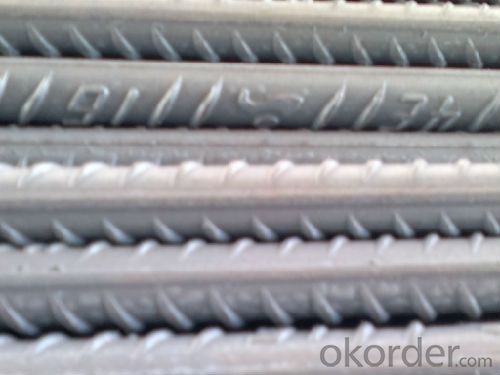
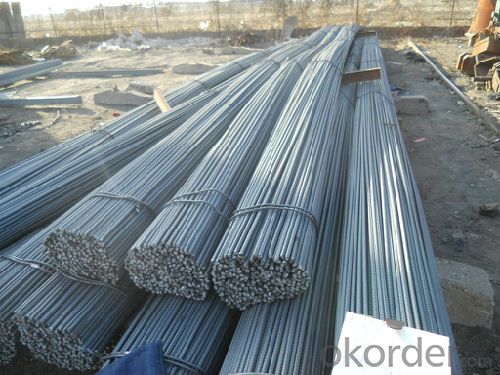
- Q:How are steel rebars connected to each other?
- Steel rebars are typically connected to each other using various methods such as overlapping, welding, or using mechanical connectors like couplers or threaded bars.
- Q:What is the impact of steel rebars on the overall carbon footprint of a construction project?
- Steel rebars have a significant impact on the overall carbon footprint of a construction project. The production of steel involves high carbon emissions due to the extraction and processing of iron ore, as well as the energy-intensive manufacturing process. Additionally, the transportation and installation of steel rebars contribute to the carbon footprint. However, the durability and strength of steel rebars offer long-term benefits by reducing the need for frequent repairs or replacements, ultimately mitigating the carbon emissions associated with maintenance. Therefore, while steel rebars contribute to the carbon footprint initially, their longevity and structural advantages can help offset these emissions over the lifespan of the construction project.
- Q:What are the advantages of using epoxy-coated stainless steel rebars?
- There are several advantages of using epoxy-coated stainless steel rebars. Firstly, the epoxy coating provides an additional layer of protection to the stainless steel rebars, thereby enhancing their corrosion resistance. Stainless steel already possesses good corrosion resistance properties, but the epoxy coating acts as a barrier against moisture, chemicals, and other corrosive elements that may come in contact with the rebars. This helps to extend the service life of the rebars and ensures the long-term durability of the structure. Secondly, epoxy-coated stainless steel rebars offer improved bond strength with concrete. The epoxy coating creates a rough surface texture, which enhances the adhesion between the rebar and the concrete. This results in a stronger bond, increasing the overall structural integrity of the reinforced concrete. Another advantage is the ease of handling and installation. The epoxy coating provides a smooth surface, making it easier to handle and position the rebars during construction. Additionally, the coating reduces the risk of injury to workers as it eliminates the sharp edges that are typically associated with bare steel rebars. Furthermore, epoxy-coated stainless steel rebars are environmentally friendly. The epoxy coating is free from harmful substances such as lead and other heavy metals, which may be present in alternative coating materials. This makes them a sustainable choice, especially in projects that prioritize environmental considerations. Lastly, epoxy-coated stainless steel rebars require minimal maintenance. The epoxy coating provides a protective layer that reduces the need for frequent inspections and repairs. This not only saves time and costs but also minimizes disruptions to ongoing construction projects. In summary, the advantages of using epoxy-coated stainless steel rebars include enhanced corrosion resistance, improved bond strength, ease of handling and installation, environmental friendliness, and reduced maintenance requirements. These benefits make epoxy-coated stainless steel rebars a reliable and cost-effective choice for reinforcing concrete structures.
- Q:How do steel rebars affect the structural capacity of concrete beams and columns?
- Steel rebars greatly enhance the structural capacity of concrete beams and columns. By reinforcing the concrete, rebars increase its tensile strength, allowing it to withstand greater loads and prevent cracking or failure. The combination of steel rebars and concrete creates a more robust and durable structure, ensuring its ability to bear heavy loads and withstand external forces.
- Q:Are steel rebars easy to cut and shape?
- Yes, steel rebars are relatively easy to cut and shape. They can be easily cut using tools such as saws or shears, and can be shaped into various forms through bending or welding.
- Q:What is the purpose of using steel rebars in construction?
- The purpose of using steel rebars in construction is to provide reinforcement and strength to concrete structures. Steel rebars enhance the structural integrity of buildings, bridges, and other constructions by improving their resistance to tension forces, preventing cracks, and enhancing overall durability.
- Q:What is the process of inspecting steel rebars on-site?
- The process of inspecting steel rebars on-site involves several steps to ensure the quality and adherence to specifications. 1. Visual Inspection: The inspector starts by visually examining the rebars for any visible defects or damage, such as rust, cracks, bends, or improper dimensions. This helps identify any immediate issues that need attention. 2. Measurement: Accurate measurements are crucial to ensure the rebars meet the required dimensions. Using tools like calipers or measuring tapes, the inspector checks the length, diameter, and shape of each rebar, comparing them against the project specifications. 3. Chemical Analysis: Some projects may require chemical analysis of the steel rebars to confirm their composition and strength. Samples are taken from different batches of rebars and sent to a lab for testing. The results determine whether the rebars meet the required standards. 4. Non-Destructive Testing (NDT): NDT techniques are employed to evaluate the internal integrity of the rebars without damaging them. Methods like ultrasonic testing, magnetic particle inspection, or radiography are used to detect any hidden defects such as cracks, voids, or inclusions. 5. Weld Inspection: If welding is involved, the inspector checks the welds for proper penetration, alignment, and quality. This ensures the integrity and strength of the joint. 6. Documentation: Throughout the inspection process, the inspector maintains detailed records of the inspections conducted, measurements taken, test results, and any identified defects. These documents serve as evidence of compliance and can be referred to in case of disputes or future reference. 7. Reporting and Communication: After completing the inspection, the inspector prepares a detailed report summarizing the findings. This report is shared with the project management team, engineers, and other relevant stakeholders, highlighting any non-compliance, defects, or areas that need attention. Overall, the process of inspecting steel rebars on-site is a comprehensive and systematic approach that ensures the quality, integrity, and compliance of the rebars with the project specifications and industry standards.
- Q:Can steel rebars be used in high-traffic flooring applications?
- Yes, steel rebars can be used in high-traffic flooring applications. Steel rebars are known for their strength and durability, making them an ideal choice for areas with heavy foot traffic. They provide added support and reinforcement to the flooring, ensuring its longevity and ability to withstand the wear and tear of high-traffic environments.
- Q:Can steel rebars be used in infrastructure projects?
- Yes, steel rebars can be commonly used in infrastructure projects. Steel rebars provide strength and durability to concrete structures, making them ideal for reinforcing various types of infrastructure such as bridges, buildings, highways, and tunnels. They help enhance the load-bearing capacity and structural integrity of these projects, ensuring their long-term stability and safety.
- Q:What are the guidelines for proper storage and transportation of steel rebars?
- The guidelines for proper storage and transportation of steel rebars are essential to ensure their integrity and quality. Here are some important guidelines to follow: 1. Storage: Steel rebars should be stored in a clean, dry, and well-ventilated area to prevent corrosion. They should be placed on a flat surface to avoid distortion or bending. Stacking should be limited to prevent excessive weight on the lower rebars, which can lead to deformation. 2. Protection: Steel rebars should be protected from exposure to moisture, rain, and direct sunlight. They should be covered with a waterproof tarp or plastic sheeting to prevent rusting. Rust can weaken the rebars and compromise their structural integrity. 3. Separation: Different sizes and grades of rebars should be stored separately to avoid confusion and ensure easy access. Additionally, rebars should be kept away from other materials that can cause damage or contamination. 4. Handling: When handling steel rebars, proper lifting techniques should be employed. Forklifts or cranes with appropriate lifting equipment should be used to prevent damage or injuries. The rebars should not be dragged or dropped, as this can cause deformation or cracking. 5. Transportation: During transportation, steel rebars should be secured properly to prevent shifting or movement that can lead to damage. Adequate cushioning materials, such as wooden blocks or rubber pads, should be used to minimize vibration and impact. Additionally, rebars should be covered to protect them from road debris and adverse weather conditions. 6. Documentation: Proper documentation is necessary for tracking the origin, size, and grade of the rebars. This information helps in ensuring compliance with industry standards and quality control measures. By adhering to these guidelines, the risk of damage, deformation, and corrosion to steel rebars during storage and transportation can be significantly reduced. This ensures that the rebars maintain their structural integrity and are fit for use in construction projects.
1. Manufacturer Overview |
|
|---|---|
| Location | |
| Year Established | |
| Annual Output Value | |
| Main Markets | |
| Company Certifications | |
2. Manufacturer Certificates |
|
|---|---|
| a) Certification Name | |
| Range | |
| Reference | |
| Validity Period | |
3. Manufacturer Capability |
|
|---|---|
| a)Trade Capacity | |
| Nearest Port | |
| Export Percentage | |
| No.of Employees in Trade Department | |
| Language Spoken: | |
| b)Factory Information | |
| Factory Size: | |
| No. of Production Lines | |
| Contract Manufacturing | |
| Product Price Range | |
Send your message to us
GB Standard HRB400, 500 Hot Rolled Deformed Steel Rebars
- Loading Port:
- Shanghai
- Payment Terms:
- TT or LC
- Min Order Qty:
- 100 m.t.
- Supply Capability:
- 200000 m.t./month
OKorder Service Pledge
OKorder Financial Service
Similar products
New products
Hot products
Hot Searches
Related keywords
